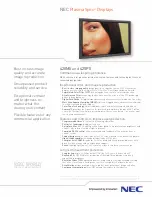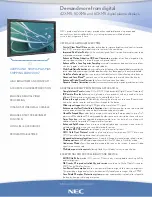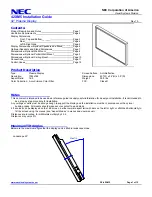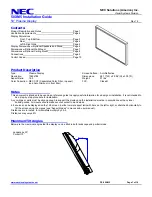
4
Technical Summary
The Optosplit II uses a conventional dichroic mirror to seperate the
light into two different spectral bands. This wavelength selection is
usually augmented by the use of bandpass filters as shown below.
The design is loosely based on technology described by Kinosita
et al
.
(
J.Cell Bio
l. (1991) 115, 67-73), but includes several proprietary features,
most notably:
A rotating mirror cradle to give precise symmetrical control of
the degree of separation whilst maintaining identical path
lengths.
A half-size fully silvered mirror at the output port for
recombining the images.
Fine adjustment controls for camera focus and vertical
alignment.
Optional ROI definition using adjustabe rectangular aperture.
The system is supplied with high grade AR coated achromatic doublet
lenses and dielectrically coated mirrors for maximum throughput.
Dimensions excluding couplings.
H55, W110, D110 (mm)
Dimensions including couplings.
H55, W261, D110 (mm)
Approximate weight.
1.26 kg
Power consumption.
0
3.6
Single channel (non-split) mode
When dual splitting is not required, the OptoSplit II unit can be used in
bypass mode, allowing the unit to remain in situ on the microscope
whilst utilising the full camera chip to generate one image.
There are several ways this can be achieved:
A
:
Removing the filter cube
Suitable if no emission filters are required in the light path
1. Remove the dichroic mirror cube (see section 2.3)
2. Centre the image using the Split control
3. Open the aperture
4. Adjust the Trim control to remove any vignetting (see section
3.5)
B: Blocking the longer wavelength path
Suitable if only the shortest wavelength channel is required
1. Leave the dichroic mirror cube in place and block the long
wavelength path using the shutter plate provided. Most
dichroic mirror have long-pass characteristics, in which case
the longest wavelength will be the transmitted channel.
(See section 4 for help differentiating the channels).
2. Centre the image using the Split control
3. Open the aperture
4. Adjust the Trim control to remove any vignetting
C: Blocking the shorter wavelength path
Suitable if only the longest wavelength channel is required
Follow the steps for option B, but block the short wavelength
path (reflected channel) with the shutter plate instead.
Direction
of light
Reflected image
Transmitted image
Split control
CCD Sensor
Aperture
Page 13
Содержание OptoSplit II
Страница 1: ...www cairn research co uk Free Phone 08453301267 UK only Tel 44 0 1795590140 Fax 44 0 1795594510 ...
Страница 2: ......
Страница 3: ......
Страница 22: ......





































